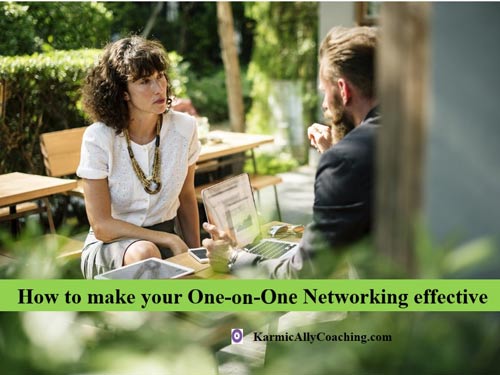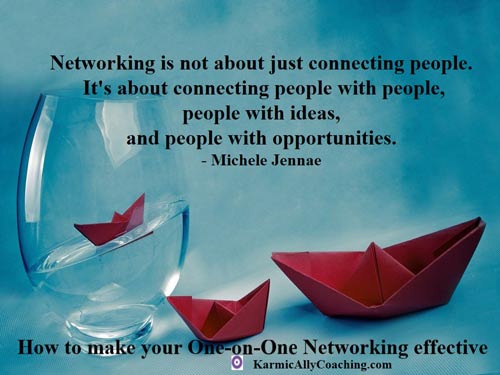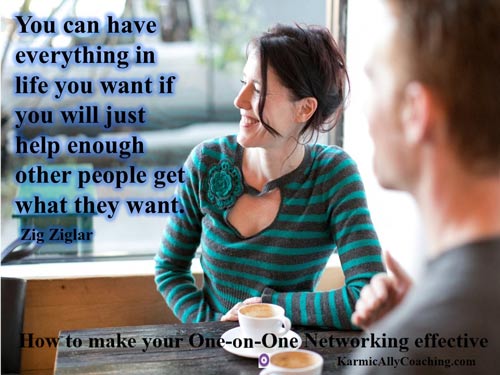This post has already been read 1480 times!

A lot of networking right now is shifting online as we continue our COVID-19 year but it doesn’t mean we can’t apply one-on-one networking practices in the virtual world.
In fact, how good are your online networking skills?
This isn’t a trick question.
It’s based on an observation I’m making on LinkedIn – the Numero Uno social media platform meant for serious networkers looking to expand their business or professional network for career progression.
It’s the number of non-personalized invitations, the people who don’t respond when you ask them their reasons for wanting to connect or hit you with a CV asking for help with getting a job or a sales pitch for a product or service without considering if you’re the right person.
And I’m not the only one. This morning I saw a post from a Career Coach who openly vented about sales pitches and pick your brain sessions that weren’t useful to either party.
Or another LinkedIn connection of mine who is a highly respected LinkedIn Trainer who received a personalized invitation to connect and then the next message after accepting the connection request was to offer him a service to improve his profile for more business leads.
In the words of Bertie Wooster – Egad.
Guess what?
That’s not networking – it’s repelling a fellow professional who can be helpful if approached the right way.
It’s also not about trying to get 30,000 people to connect with you without knowing anything about them.
If you’re making this mistake because someone told you ‘connect and build a network’, then there is a vital piece of the equation that they might not have mentioned.
Or if they did, you didn’t hear it because you focused on doing 1 click invites to build an enviable 30,000 network.
Networking on LinkedIn isn’t a numbers game…
…it’s about making a meaningful connection with someone you can learn from, who in turn can teach you new things.
On LinkedIn, it’s about being able to communicate with the connection and develop a real contact. That communication could be in writing at first and then even a telephone call or a meeting if you’re in the same city.
In other words, communication is important and if you can do it on the phone, Skype or in person, brownie points!
Unfortunately, this makes networking suddenly seem more intimidating.
This is where time spent learning how to network can be valuable.
- Take time to practice having conversations.
- Start by talking to family and friends.
- Practice your listening skills.
Then once you’ve learned what it means to engage with others, practice again on those people you’ve lost touch with over the years, (and rebuild some great relationships in the process.)
Once you feel confident, take this newfound knowledge into the field, and test it on the people you want most to connect with and meet whether virtually or in person.
Will every encounter come out perfect? Probably not…
If you keep in mind every conversation becomes an opportunity to learn, you will soon be feeling more confident each time you meet someone new.
And if you’re thinking in these days of social distancing you can’t network, then let go of that excuse. It’s a limiting belief giving you permission to avoid conversations.
You can do it on LinkedIn and you can start doing it right now by contacting your contacts and start building meaningful relationships.
Drop them a line and ask how they’ve been? You don’t need an ulterior motive or agenda. Just be human and authentic.
If you’re not sure about how to invite and engage with new connections, I’ve got a post with the 10 rules of engagement you need to keep in mind when networking on LinkedIn including the story of a real Missing Link I met on LinkedIn.
In fact, you can use the same guidance on Facebook if that’s your favorite place to hang out.
5 Professional Tips for One-on-One Networking
Not all networking happens at live events. Some of the most effective networking you can do happens over coffee meetings.
One-on-one catch ups, whether they’re in real life or virtual, give you a chance to really connect without the distractions of being in a big crowd.
More often than not, I’ve noticed professionals ignore their existing or hidden network and reach out to strangers on social media, especially LinkedIn and Facebook when approaching a warm network would be more beneficial than cold networking.
Recently a highly experienced professional approached me for help with his job hunt and the fact that I was not in recruitment or executive search didn’t stop him from asking. That’s alright because I told him to contact the right people for achieving his job hunt goal.
As it turned out, we had 3 common connections and one of them was in talent management services.
There was no excuse for not renewing this contact other than the resistance arising from having been out of touch. According to this professional, he wanted to try out other professionals before turning to his existing network that he had not been in touch with.
Here’s the thing. It’s very easy to fall out of touch with people. It happens with the best of us.
We get busy with our jobs and family life and only remember them when we are in trouble.
Then we feel sheepish about asking for help and go off on a tangent asking strangers who don’t know us from Adam or Eve for help and expect miracles.
There’s simpler way to have a robust network.
Maintain contact with your current network and all of the people in it is going to help you grow.
Follow up with people – your mentors, colleagues, and other contacts – on a regular basis to see how they’re doing.
Keep them up to date on you as well. Remember, don’t make it all about you; you will want them to know what you’re up to while also finding out what they’ve been up to.
Does that sound like a Herculean task?
Here’s a quick tip – at least send them a greeting on their birthdays and on festivals. You’ll stay top of mind and you never know, it might bring up the chance to actually catch up and make the connection stronger.
As with other professional activities where you are investing time and effort, you need to have a plan and more importantly a method to make it effective.
Here are five tips to make your one-on-one networking even more effective.
Always have a purpose for the networking meeting
Whether your networking meeting is taking place offline like say a coffee meeting or a virtual one over Zoom or Skype, your networking meeting is more likely to be effective if it’s clear why it’s happening.
In other words, what’s the purpose of the meeting?
Are you looking for a mentor, or a new position? Has the person been recommended to you? Maybe you’re new in town and looking to connect with peers.
If it’s a get-to-know-you meeting, it’s okay to talk about common interests like books, movies, or sports.
The other person’s time is valuable too and its important to make sure you’re both meeting for a good reason.
Picking their brains for free advice is not a good purpose!

Be strategic
Do your research and identify leaders that you really want to connect with. Be clear about where you want to be in a year, five years’ time and seek out the people who can help you get there.
Part of the point of networking is not just the people you meet, but the people they know who can help you grow your own network.
If you have changed jobs, sectors, or towns, connecting with the right people can help you hit the ground running.
Make the meeting mutually beneficial
I mentioned earlier that picking someone’s brains for free advice is not a good purpose for a meeting unless of course you have made that intention clear at the time of inviting the person to the meeting and they have agreed.
A good networking meeting isn’t just about what you can get out of the other person – there has to be some benefit for them too. It’s what I call netweaving – an activity that can make you a valuable connection for others.

Think about what you can offer. What are your special skills or connections? Do you have acquaintances or experiences in common?
Pay the other person the respect of doing some background research so you know where they’re from, and what their career path and big projects have been.
Networking is a Two-Way Street.
When someone helps you out and makes a positive connection for you, then you have to be sure that you give back in some way. You simply can’t keep going back and asking for help without giving back in return.
The giving back can take many forms. Maybe a box of chocolates if they’ve helped you get a job or even an introduction to another contact of yours who can be beneficial to their business or work. Sometimes even a sincere letter of thanks or a recommendation on LinkedIn works.
Keep an eye out for their interests and make an introduction at an opportune moment. The choices are not restricted.
Respect your new contact’s time
Remember this person has made time for you in their day. Be respectful of that and keep to the agreed time (don’t be late!).
Don’t hog the conversation, and make sure the meeting doesn’t go over time, unless the other person is keen to keep talking. In an offline setting, you can give them your business card, but don’t hand over your resume or a pitch book for business unless it’s requested.
Likewise, if the meeting is virtual, don’t send the resume or a business proposal unless they have asked you for it.
Remember your manners
Be polite during your meeting and remember to follow up within twenty-four hours with a brief email thanking them for taking time out to talk.
Gratitude goes a long way. When someone helps you in whatever way, being grateful will go a long way.
After having a conversation with someone in person or online, send them a quick thank you note for their time.
It’s a small thing, but letting people know they are appreciated will go a long way and encourage them to want to speak with you again.
If you committed to sending an article or book refence, remember to follow up. You want this first meeting to set the tone for a future meaningful relationship.
Whether you’re building an offline or online network, the basics of professionalism and good manners stay the same.
Treat the other person the way you would wish to be treated and you can’t go wrong.
Happy Networking!




 I adhere to the Certified Coaches Alliance Code of Ethics and Standards. A copy is available on request.
I adhere to the Certified Coaches Alliance Code of Ethics and Standards. A copy is available on request.
 Let's Talk through the Connect Form:
Let's Talk through the Connect Form:
Great post Vatsala! You’ve managed to list and answer my pet peeves around LinkedIn and how it can be used or abused. Thanks for sharing it out loud!
Thanks Barb. Delighted you found the post useful. We all have common pet peeves around LinkedIn.
Great post Vatsala! Some useful networking tips. I particularly linked the concept of “netweaving”. Thanks for sharing your wisdom.
Netweaving is one of my favorite ways to demonstrate that I care about my connections and can be of service, Pamela. Glad you liked the post and networking tips.
Wow, I learned more about networking than I ever knew before. Thanks!
Welcome Barb!
Thank you for this inspiring post Vatsala! It’s timely for me as I’ve challenged myself to network with my community and collegues more. Networking has historically been difficult for me and your article gives me ideas on how to embrace this process with confidence. Many blessings xo
Honored to be of service, Debra. Networking can feel daunting in the beginning but practice makes perfect. And being authentic helps.
I love the reminder that networking is about making meaningful connections with someone who you can learn from and can reciprocate. Your 5 professional tips are great, especially having a purpose when you attend a networking event and making everything mutually beneficial. Thank you for sharing your wisdom and insights!
My pleasure Kelley. When we approach networking from a place of service and try to see how we can help the other party, it lays the foundations for a genuine win-win connection.